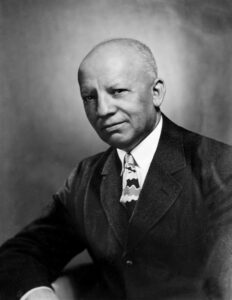Published: 2/7/2024
Reading Time: 4 minutes
The national theme for Black History Month 2024 is “African Americans and the Arts.”
Black History Month 2024 is a time to recognize and highlight the achievements of Black artists and creators, and the role they played in U.S. history and in shaping our country today.
To commemorate this year’s theme, we’ve gathered powerful quotes about learning, culture and equality from five historic Black American authors, teachers and artists who made a significant impact in the Arts, education ― and the nation.
Making history
“Real education means to inspire people to live more abundantly, to learn to begin with life as they find it and make it better.”
– Carter G. Woodson, Author, Journalist, Historian and Educator, 1875-1950
Known as the “Father of Black History,” Carter G. Woodson was primarily self-taught in most subjects. In 1912, he became the second Black person to receive a Ph.D. from Harvard.
He is the author of more than 30 books, including “The Mis-Education of the Negro.”
Carter G. Woodson dedicated his life to teaching Black History and incorporating the subject of Black History in schools. He co-founded what is now the Association for the Study of African American Life and History, Inc. (ASALH). In February 1926, Woodson launched the first Negro History Week, which has since been expanded into Black History Month.

Providing a platform
“I have created nothing really beautiful, really lasting, but if I can inspire one of these youngsters to develop the talent.”
– Augusta Savage, Sculptor, 1892-1962
An acclaimed and influential sculptor of the Harlem Renaissance, Augusta Savage was a teacher and an activist who fought for African American rights in the Arts. She was one out of only four women, and the only Black woman, commissioned for the 1939 New York World’s Fair. She exhibited one of her most famous works, “Lift Every Voice and Sing,” which she named after the hymn by James Weldon Johnson, sometimes referred to as the Black National Anthem. Her sculpture is also known as “The Harp,” renamed by the fair’s organizers.

Raising a voice
“My mother said to me ‘My child listen, whatever you do in this world no matter how good it is you will never be able to please everybody. But what one should strive for is to do the very best humanly possible.’”
– Marian Anderson, American Contralto, 1897-1993
Marian Anderson broke barriers in the opera world. In 1939, she performed at the Lincoln Memorial in front of a crowd of 75,000 after the Daughters of the American Revolution (DAR) denied her access to the DAR Constitution Hall because of her race. And in 1955, Marian Anderson became the first African American to perform at the Metropolitan Opera. She sang the leading role as Ulrica in Verdi’s Un Ballo in Maschera.

Influencing the world
“The artist’s role is to challenge convention, to push boundaries, and to open new doors of perception.”
– Henry Ossawa Tanner, Painter, 1859-1937
Henry Ossawa Tanner is known to be the first Black artist to gain world-wide fame and acclaim. In 1877, he enrolled at the Pennsylvania Academy of the Fine Arts, where he was the only Black student. In 1891, Tanner moved to Paris to escape the racism he was confronted with in America. Here, he painted two of his most recognized works, “The Banjo Lesson” and “The Thankful Poor of 1894.”
In 1923, Henry O. Tanner was awarded the Chevalier of the Legion of Honor by the French government, France’s highest honor.

Rising up
“Wisdom is higher than a fool can reach.”
– Phillis Wheatley, Poet, 1753-1784
At about seven years old, Phillis Wheatley was kidnapped from her home in West Africa and sold into slavery in Boston. She started writing poetry around the age of 12 and published her first poem, “Messrs. Hussey and Coffin,” in Rhode Island’s Newport Mercury newspaper in 1767.
While her poetry spread in popularity ― so did the skepticism. Some did not believe an enslaved woman could have authored the poems. She defended her work to a panel of town leaders and became the first African American woman to publish a book of poetry. The panel’s attestation was included in the preface of her book.
Phillis Wheatley corresponded with many artists, writers and activists, including a well-known 1774 letter to Reverand Samson Occom about freedom and equality.

Honoring Black History Month 2024
Art plays a powerful role in helping us learn and evolve. Not only does it introduce us to a world of diverse experiences, but it helps us form stronger connections. These are just a few of the many Black creators who shaped U.S. history ― whose expressions opened many doors and minds.
Black History Month is observed each year in February. To continue your learning, go on a journey with Dr. Jewrell Rivers, as he guides you through Black History in higher education. Read his article, “A Brief History: Black Americans in Higher Education.”






